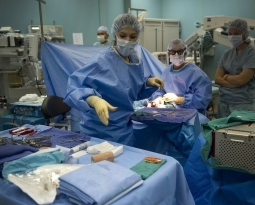New Mexico Patent of the Month – August 2023
Sandia Biotech, Inc., a research partner and OEM, has revolutionized the landscape of antibody production with their groundbreaking method for creating chimeric antibodies. These antibodies, known for their ability to combine the specificity of natural antibodies with the versatility of synthetic elements, have long held immense promise for research and medical applications. However, their production has been fraught with challenges, until now.
Sandia Biotech has introduced a method that streamlines and optimizes the process of creating chimeric antibodies. This method involves a meticulous step-by-step approach that combines various elements crucial to the antibody’s functionality.
Imagine being able to consistently and successfully merge any single-chain variable fragment (scFv) of an antibody with any fluorescent protein, resulting in the creation of a stable, functional, and predominantly soluble chimeric antibody. Sandia Biotech’s revolutionary approach makes this possible.
Traditionally, creating these chimeric antibodies involved a complex series of steps, from gene digestion to ligation and bacterial transformation. Sandia Biotech, Inc. has replaced this cumbersome process with the innovative Gibson Assembly method. This approach enables the simultaneous cloning of DNA sequences using PCR templates with overlapping regions, reducing the complexity and time required for production.
What sets Sandia Biotech’s method apart is its emphasis on optimizing linker length. The linker, a critical element between the fluorescent protein and scFv fragments, ensures proper alignment and folding. Sandia Biotech’s system systematically determines the optimal linker length based on the scFv fragment lengths, ensuring consistent and reliable chimeric antibody production.
This breakthrough is not only technically impressive but also highly practical. Sandia Biotech’s approach slashes the production time of chimeric antibodies from weeks to just a 2-week turnaround, significantly accelerating research and development efforts.
Are you developing new technology for an existing application? Did you know your development work could be eligible for the R&D Tax Credit and you can receive up to 14% back on your expenses? Even if your development isn’t successful your work may still qualify for R&D credits (i.e. you don’t need to have a patent to qualify). To find out more, please contact a Swanson Reed R&D Specialist today or check out our free online eligibility test.
Who We Are:
Swanson Reed is one of the U.S.’ largest Specialist R&D tax advisory firms. We manage all facets of the R&D tax credit program, from claim preparation and audit compliance to claim disputes.
Swanson Reed regularly hosts free webinars and provides free IRS CE and CPE credits for CPAs. For more information please visit us at www.swansonreed.com/webinars or contact your usual Swanson Reed representative.

















